Urban Wind Field Mapping Technique for Municipal Environmental Planning: A Case Study of Cheongju-Si, Korea
Abstract
1. Introduction
2. Literature Review
3. Methods
3.1. Research Workflow
3.2. Data Collection
3.2.1. Local Data Assimilation and Prediction System and Weather Station Observation Data
3.2.2. Terrain and Land Cover Data
3.3. Modelling
3.4. Study Area for Pilot Test Mapping
4. Results
4.1. Verification of the Performance of WRF and CALMET
4.2. Characteristics of Wind Field in Cheongju-Si
4.3. Implication of Wind Field Maps to Environmental Plan in Cheongju-Si
5. Discussion
5.1. Utilization of the Wind Field Map for EPs
5.2. Potentially More Simplified Wind Field Mapping
5.3. Limitation of the Proposed Wind Field Mapping and Suggestion
6. Conclusions
Author Contributions
Funding
Institutional Review Board Statement
Informed Consent Statement
Data Availability Statement
Acknowledgments
Conflicts of Interest
References
- Gyeonggi Research Institute. Production of Climatic Atlas of Gyeonggi-do: Final Report; Gyeonggi Provincial Government: Suwon, Korea, 2010. (In Korean) [Google Scholar]
- Oh, D.; Yeo, W. Urban Climate Mapping for Urban Planning; Busan Development Institute: Busan, Korea, 2014. (In Korean) [Google Scholar]
- Seoul Institute. Final Report: Seoul Climate Environment Energy Mapping Research (4th Year); Seoul Metropolitan Government: Seoul, Korea, 2016. (In Korean) [Google Scholar]
- Ministry of Environment & Ministry of Land, Infrastructure and Transportation. Joint Ordinance for Integrated Management of Environmental Plans and Land Plans; Ministry of Environment & Ministry of Land, Infrastructure and Transportation: Sejong, Korea, 2018. (In Korean) [Google Scholar]
- Ministry of Environment. A Guideline for Environmental Planning for the Local Governments; Ministry of Environment: Sejong, Korea, 2021. (In Korean) [Google Scholar]
- Ren, C.; Ng, E.; Katzschner, L. Urban climatic map studies: A review. Int. J. Climatol. 2011, 31, 2213–2233. [Google Scholar] [CrossRef]
- Baumüller, J.; Reuter, U. Demands and Requirements on a Climate Atlas for Urban Planning and Design; Office of Environmental Protection: Stuttgart, Germany, 1999. [Google Scholar]
- Nachbarschaftsverband Stuttgart. Klimaastlas. Landeschauptstadt Stuttgart, Amt fur Umweltschutz; Abteilung Stadtklimatologie: Stuttgart, Germani, 1992. (In German) [Google Scholar]
- Baumüller, J. Implementation of climatic aspects in urban development: The example Stuttgart. In Urban Climate + Urban Greenery; PGBC: Hong Kong, China, 2006; pp. 42–52. [Google Scholar]
- Landshaftsplan. Available online: https://www.berline.de/sen/uvk/natur-und-gruen/landschaftsplanung/landschaftsplan/ (accessed on 20 July 2022). (In German).
- Environmental Atlas. Available online: https://www.berlin.de/umweltatlas/en/ (accessed on 20 July 2022).
- Environmental Atlas of Berlin in FIS-BROKER. Available online: https://fbinter.stadt-berlin.de/fb/index.jsp?Szenario=fb_en (accessed on 20 July 2022).
- Tokyo Metropolitan Government. The Thermal Environment Map and Areas Designated for the Implementation of Measures Against the Heat Island Phenomenon; Bureau of the Environment, Tokyo Metropolitan Government: Tokyo, Japan, 2005. [Google Scholar]
- Ng, E.; Katzschner, L.; Wang, U.; Ren, C.; Chen, L. Working Paper No. 1A: Draft urban climatic analysis map—Urban climatic map and standards for wind environment—Feasibility study. In Technical Report for Planning Department HKSAR; The Chinese University of Hong Kong: Hong Kong, China, 2008. [Google Scholar]
- Planning Department Hong Kong SAR. Urban Climatic Map and Standards for Wind Environment—Feasibility Study—Final Report; Department of Architecture, The Chinese University of Hong Kong: Hong Kong, China, 2009. [Google Scholar]
- Höppe, P.R. The physiological equivalent temperature—A universal index for the biometeorological assessment of the thermal environment. Int. J. Biometeorol. 1999, 43, 71–75. [Google Scholar] [CrossRef] [PubMed]
- Matzarakis, A.; Meyer, H.; Iziomon, M. Application of a universal thermal index: Physiological equivalent temperature. Int. J. Biometeorol. 1999, 43, 76–84. [Google Scholar] [CrossRef] [PubMed]
- Go, J.; Shin, Y.; Kil, J.; Hong, G.; Kim, J. Linkage Policy of Land Planning and Environment Planning in Germany; National Institute of Environmental Research: Incheon, Korea, 2015. (In Korean) [Google Scholar]
- Yi, C.; Eum, J.-H.; Choi, Y.-J.; Kim, K.R.; Scherer, D.; Fehrenbach, U.; Kim, G.-H. Development of Climate Analysis Seoul (CAS) maps based on land use and meteorological model. J. Korean Assoc. Geographic. Inf. Stud. 2011, 14, 12–25, (In Korean with English abstract). [Google Scholar] [CrossRef][Green Version]
- Map service for Seoul Urban Planning Portal. Available online: http://urban.seoul.go.kr/view/map/main.html (accessed on 20 July 2022). (In Korean).
- Seoul Institute. Environmental Conservation Plan for City of Seoul (2016–2025); Seoul Metropolitan Government: Seoul, Korea, 2016. (In Korean) [Google Scholar]
- Seoul Metropolitan Government & Seoul Institute. 2030 Seoul Master Plan: 2030 Seoul Plan; Seoul Metropolitan Government: Seoul, Korea, 2014. (In Korean) [Google Scholar]
- Chungbuk Research Institute. Cheongju-si Environmental Conservation Plan (2016–2025); Ministry of Environment & Cheongju-si: Cheongju, Korea, 2016. (In Korean) [Google Scholar]
- Seoul Metropolitan Office of Meteorology. Near Surface Wind Information over the West Coast of Gyeonggi; Seoul Metropolitan Office of Meteorology: Suwon, Korea, 2017. (In Korean) [Google Scholar]
- Seoul Metropolitan Office of Meteorology. Research on the Technical Improvement of Detailed Meteorological Information Generation in the Seoul Metropolitan Region; Seoul Metropolitan Office of Meteorology: Suwon, Korea, 2019. (In Korean) [Google Scholar]
- Gwangju Office of Meteorology. Development of Techniques for Producing Climate Impact Information according to Urban Environment Change; Gwangju Office of Meteorology: Gwangju, Korea, 2020. (In Korean) [Google Scholar]
- Korea Meteorological Administration (KMA). Textbook for Training Weather Forecasters: Beginner Course; Korea Meteorological Administration: Seoul, Korea, 2012. (In Korean) [Google Scholar]
- Hong, S.; Kwon, Y.C.; Kim, T.; Kim, J.E.; Choi, S.; Kwon, I.; Kim, J.; Lee, E.; Park, R.; Kim, D. The Korean Integrated Model (KIM) system for global weather forecasting. Asia-Pac. J. Atmos. Sci. 2018, 54, 267–292. [Google Scholar] [CrossRef]
- Park, K. Korean’s Journey Toward Objective, Scientific Weather Forecasts. The Korea Herald, 24 August 2021, page 4. Available online: http://news.koreaherald.com/view.php?ud=20210823000326&md=20210826003320_BL (accessed on 20 July 2022).
- Brown, A.; Milton, S.; Cullen, M.; Golding, B.; Mitchell, J.; Shelly, A. Unified modeling and prediction of weather and climate: A 25-year journey. Bull. Am. Meteorol. Soc. 2012, 93, 1865–1877. [Google Scholar] [CrossRef]
- Open Portal for Weather Data by Korea Meteorological Administration (KMA). Available online: https://data.kma.go.kr (accessed on 20 July 2022). (In Korean).
- Environmental Geographic Information Service (EGIS) by Ministry of Environment. Available online: https://egis.me.go.kr (accessed on 20 July 2022). (In Korean).
- Kim, J.C. Evaluation and Prediction of High Resolution Climate Simulation by Land Surface Data Improve over Complex Terrain. Ph.D. Thesis, Kangwon National University, Chuncheon, Korea, 2010. (In Korean with English abstract). [Google Scholar]
- Jeon, K.; Kim, Y. Study on improvement to accuracy of CALMET using a surface roughness length of landuse. J. Korean Soc. Urban Environ. 2016, 16, 383–392, (In Korean with English abstract). [Google Scholar]
- National Institute of Environmental Research (NIER). Precise Mapping and Spatial Analysis of the Environmental Information (III)—Focusing on Climate Change; National Institute of Environmental Research: Incheon, Korea, 2017. (In Korean) [Google Scholar]
- National Land Information Platform by National Geographic Information Institute (NGII). Available online: http://map.ngii.go.kr (accessed on 20 July 2022). (In Korean).
- Skamarock, W.C.; Klemp, J.B.; Dudhia, J.; Gill, D.O.; Barker, D.M.; Duda, M.; Huang, X.-Y.; Wang, W.; Powers, J.G. A Description of the Advanced Research WRF Version 3; NCAR Technical Note TN-475+STR; NCAR: Boulder, CO, USA, 2008. [Google Scholar]
- Scire, J.S.; Robe, F.R.; Fernau, M.E.; Yamartino, R.J. A User’s Guide for the CALMET Meteorological Model (Version 5); Earth Tech Inc.: Concord, MA, USA, 2000. [Google Scholar]
- Perego, S. Metphomod—A numerical mesoscale model for simulation of regional photosmog in complex terrain: Model description and application during Pollumet 1993 (Switzerland). Meteorol. Atmos. Phys. 1999, 70, 43–69. [Google Scholar] [CrossRef]
- Kim, K.R.; Yi, C.; Lee, J.-S.; Meier, F.; Jänicke, B.; Fehrenbach, U.; Scherer, D. BioCAS: Biometeorological Climate impact Assessment System for building-scale impact assessment of heat-stress related mortality. J. Geograph. Soc. Berlin 2014, 145, 62–79. [Google Scholar]
- Yi, C.; Kim, K.R.; An, S.M.; Choi, Y.-J.; Holtmann, A.; Jänicke, B.; Fehrenbach, U.; Scherer, D. Estimating spatial patterns of air temperature at building-resolving spatial resolution in Seoul, Korea. Int. J. Climatol. 2016, 36, 533–549. [Google Scholar] [CrossRef]
- Scire, J.S.; Strimaitis, D.G.; Yamartino, R.J. A User’s Guide for the CALPUFF Dispersion Model (Version 5); Earth Tech Inc.: Concord, MA, USA, 2000. [Google Scholar]
- CALPUFF Modeling System Version 6 User Instruction (April 2011). Available online: https://www.src.com/calpuff/download/CALPUFF_Version6_Userinstructions.pdf (accessed on 22 October 2022).
- California Air Resources Board and South Coast Air Quality Management District (CARB & SCAQMD). Modeling Protocol for Ozone and Particulate Matter Modeling in Support of the South Coast Air Quality Management District 2007 Air Quality Management Plan Update; CARB & SCAQMD: Sacramento, CA, USA, 2006. [Google Scholar]
- Byon, J.-Y.; Choi, Y.-J.; Seo, B.-K. Characteristics of a wind map over the Korean Peninsula based on mesoscale model WRF. Atmosphere 2010, 20, 195–210, (In Korean with English abstract). [Google Scholar]
- Hernández, A.; Saavedra, S.; Rodríguez, A.; Souto, J.A.; Casares, J.J. Coupling WRF and CALMET Models: Validation During Primary Pollutants glc Episodes in an Atlantic Coastal Region. In Air Pollution Modeling ang Its Applications XXII. NATO Science for Peace and Security Series C: Environmental Security; Steyn, D., Builties, P., Timmermans, R., Eds.; Springer: Dordrecht, The Netherlands, 2014; pp. 681–684. [Google Scholar] [CrossRef]
- Kim, A.-L.; Koo, Y.-S. A study on the improvement of prediction performance of fine scale wind fields using WRF and CALMET models in the complex coastal area. J. Kor. Soc. Urban Environ. 2016, 16, 83–95. [Google Scholar]
- Lee, H.-W.; Kim, D.-H.; Kim, M.J.; Lee, S.H.; Park, S.Y.; Kim, H.G. Study of evaluation wind resource detailed area with complex terrain using combined MM5/CALMET system. Proceedings of Autumn Conference of The Korean Society of New Renewable Energy, Busan, Korea, 16 October 2008; Korean Soc. New Renew. Energy2008. pp. 274–277, (In Korean with English abstract). [Google Scholar]
- Robe, F.R.; Scire, J. Combining mesoscale prognostic and diagnostic wind models: A practical approach for air quality applications in complex terrain. In Proceedings of the 10th Conference on the Applications of Air Pollution Meteorology, Phoenix, AZ, USA, 11–16 January 1998. [Google Scholar]
- Sievers, U.; Kossmann, M. The cold air drainage model KLAM_21—Model formulation and comparison with observations. Weather. Clim. 2016, 36, 2–24. [Google Scholar] [CrossRef]
- Cold Air Drainage Model KLAM_21. Available online: https://www.dwd.de/EN/ourservices/klam_21/klam-21.html (accessed on 20 July 2022).
- Seo, B.; Jeong, E. Comparative analysis of wind flows in wind corridor based on spatial and geomorphological characteristics to improve urban thermal environments. J. Korean Assoc. Geogr. Inf. Stud. 2017, 20, 75–88, (In Korean with English abstract). [Google Scholar]
- Bruse, M. Development of a Microscale Model for the Calculation of Surface Temperatures in Structured Terrain. Master’s Thesis, Institute of Geography at the Ruhr-University Bochum, Bochum, Germany, 1998. [Google Scholar]
- ENVI-MET. Available online: https://www.envi-met.com (accessed on 20 July 2022).
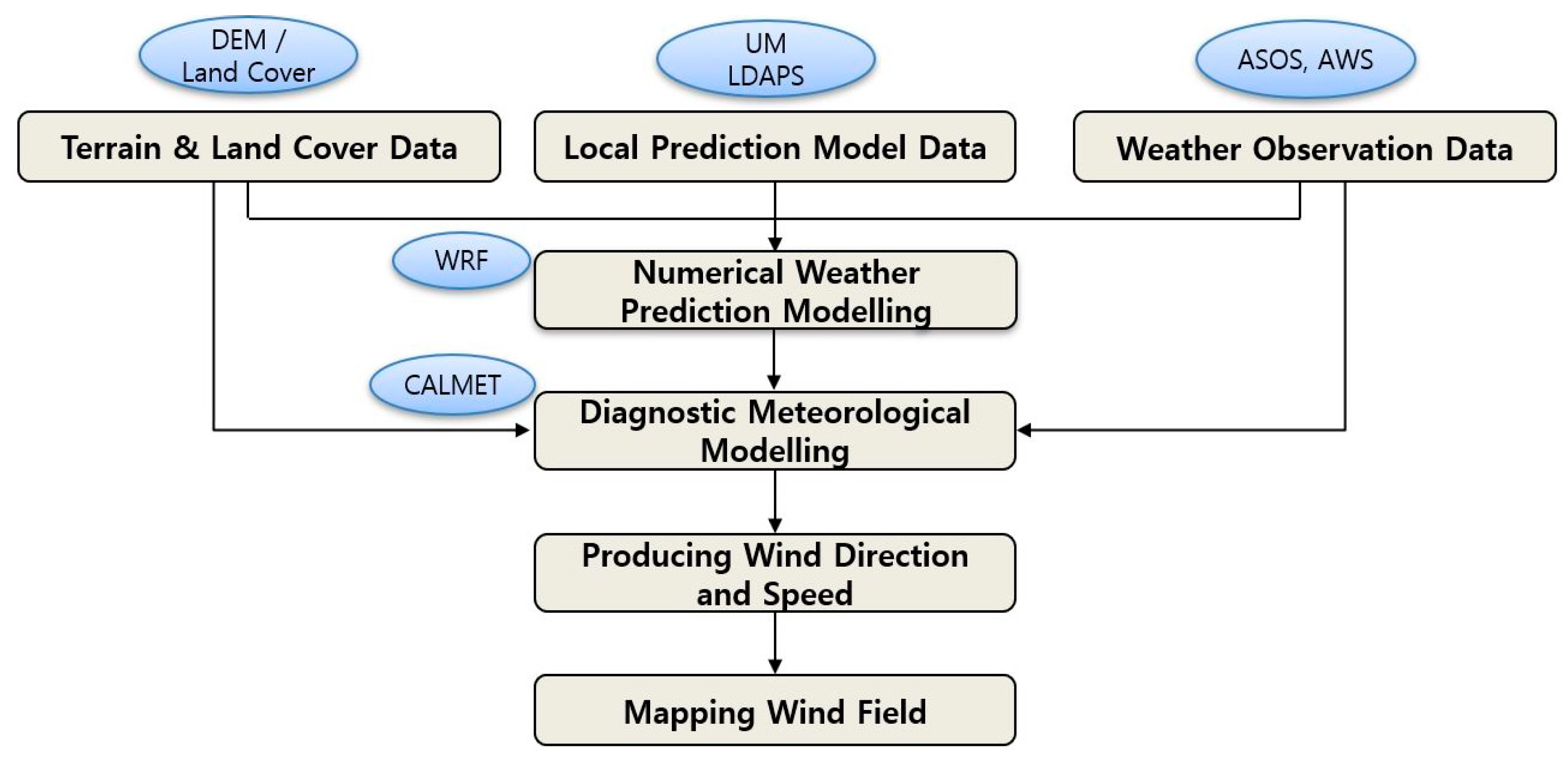

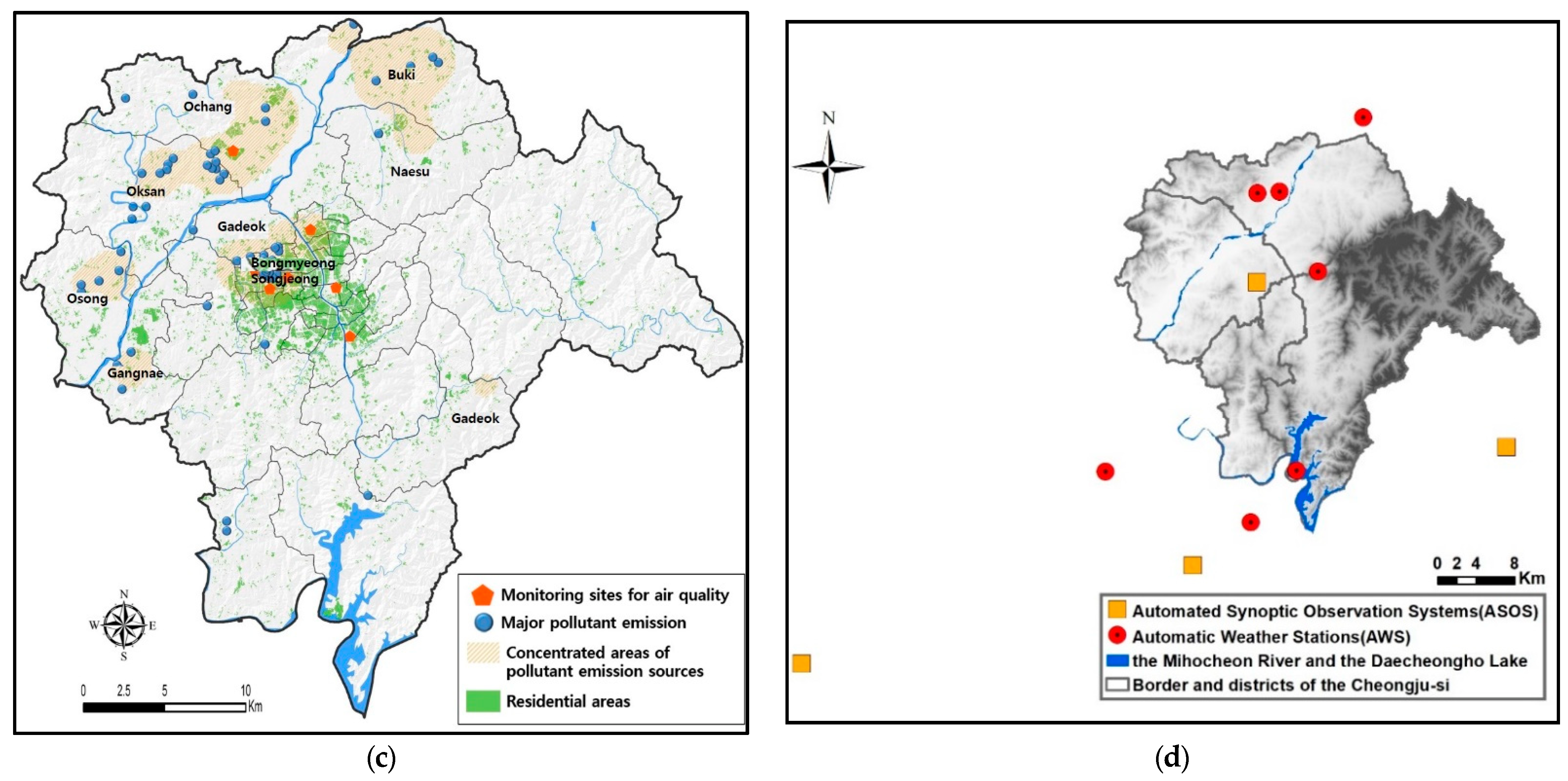
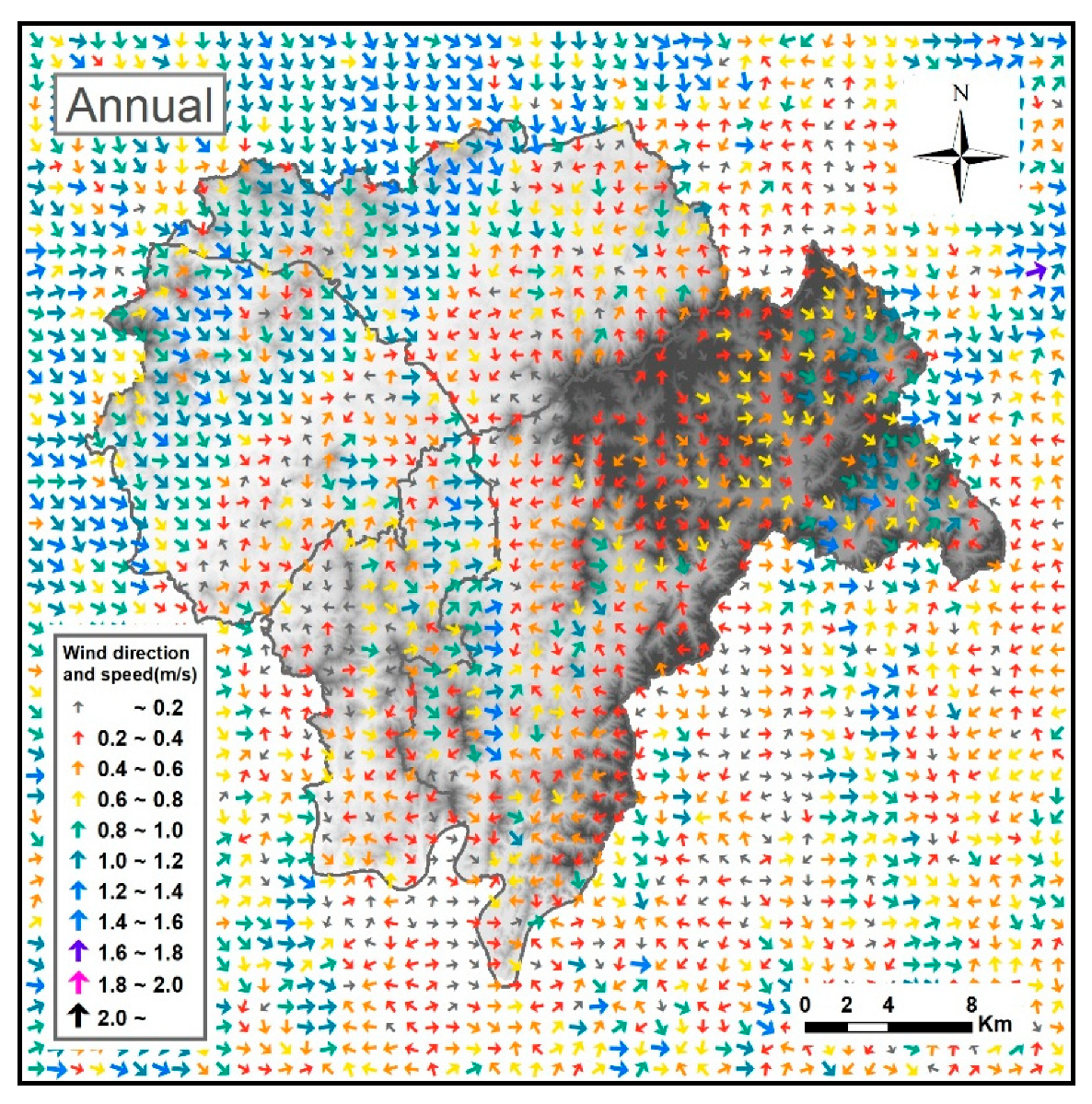
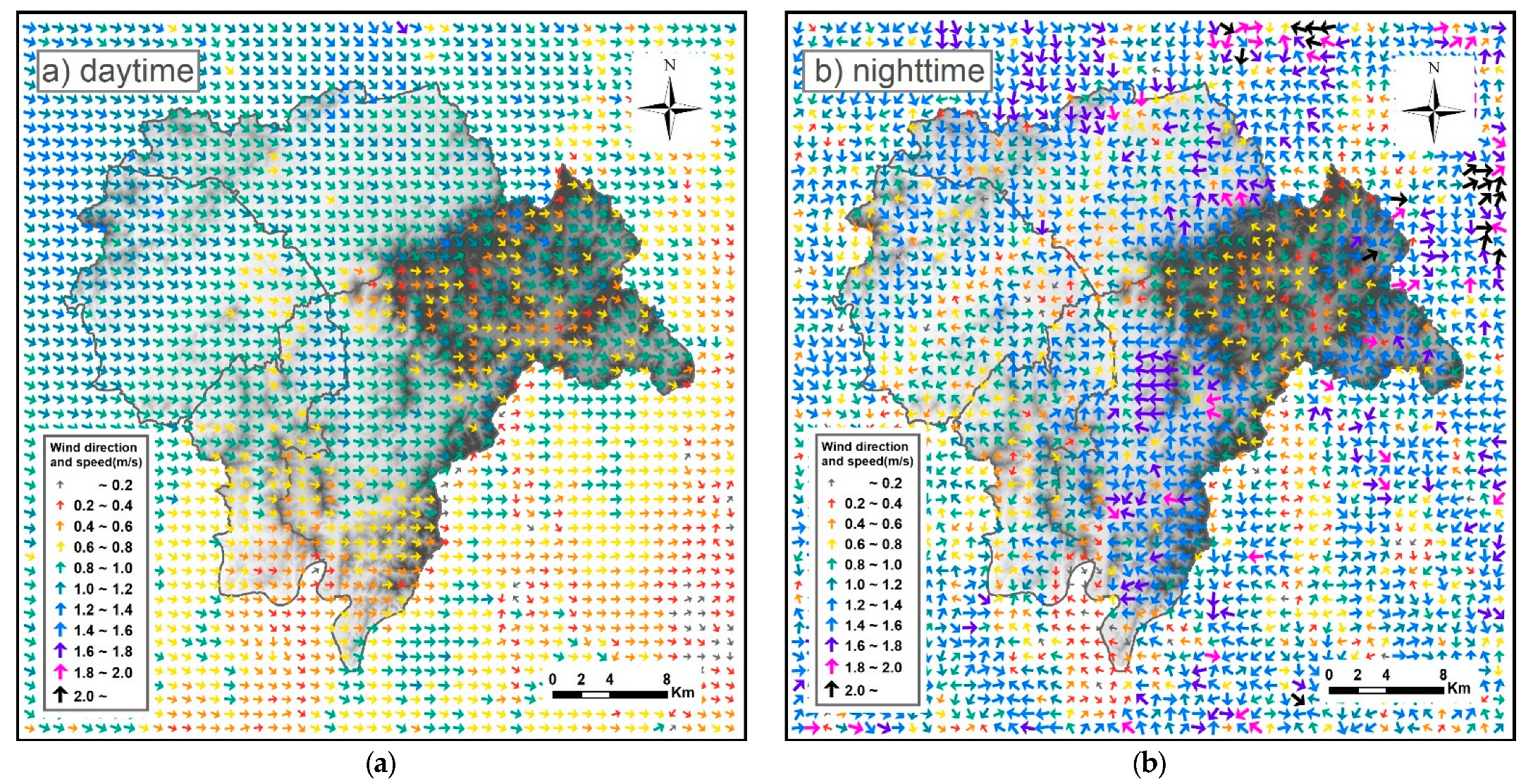
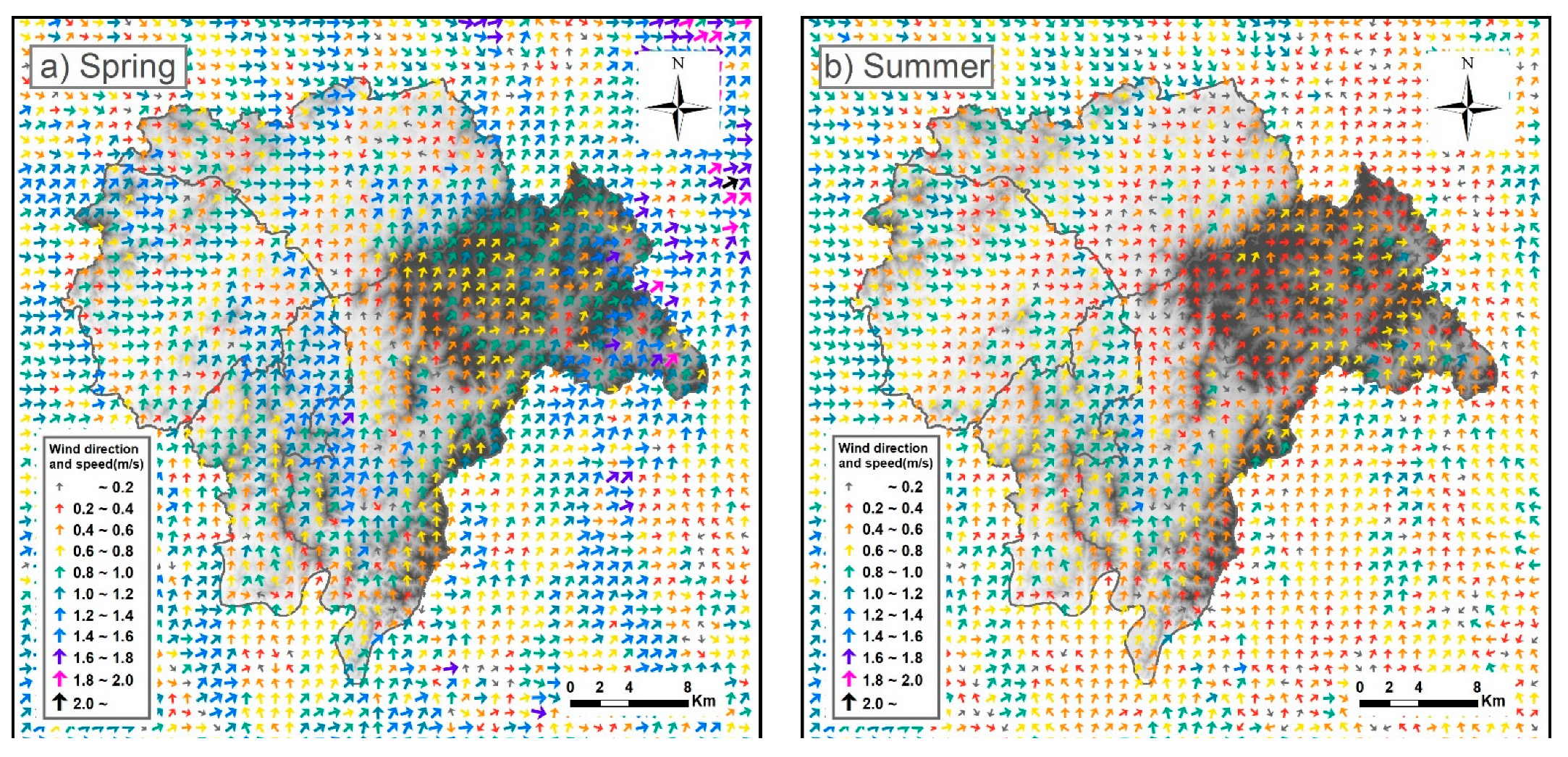

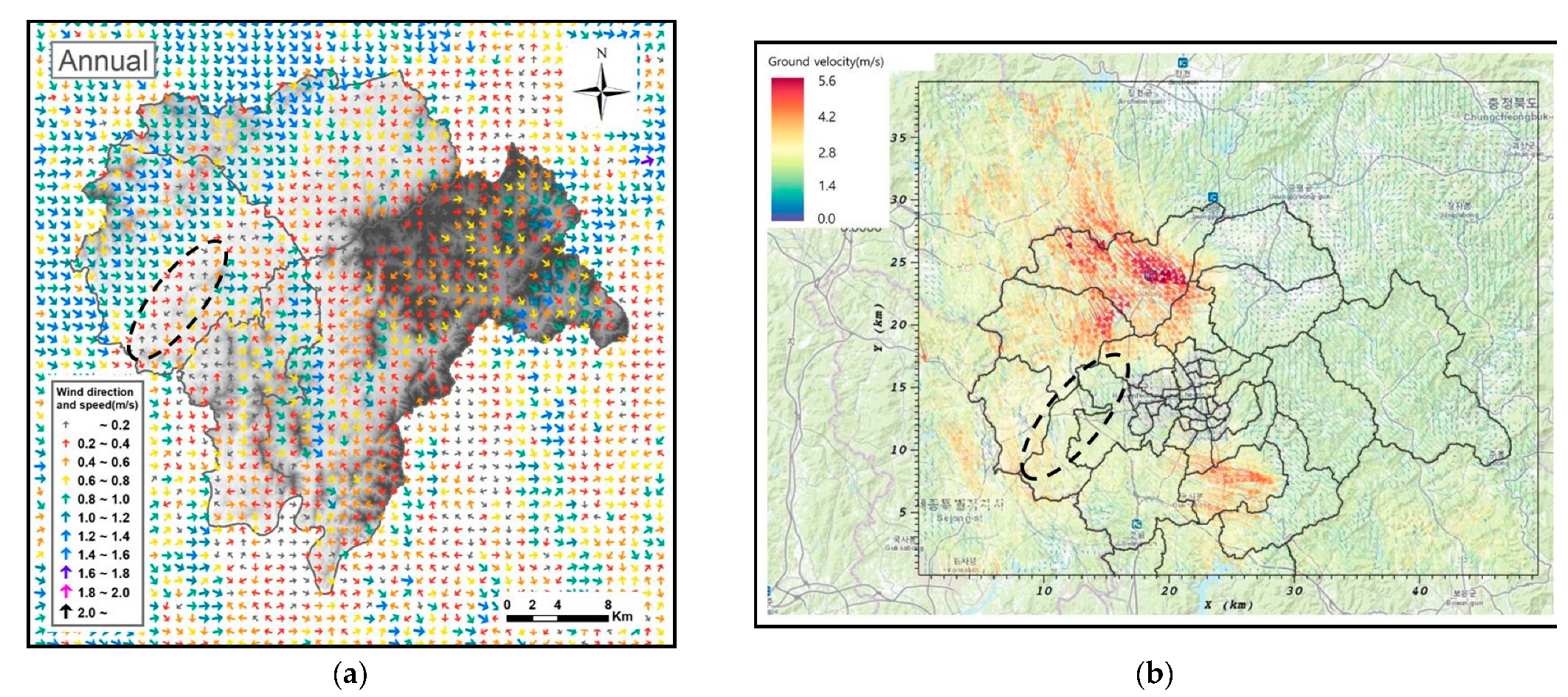
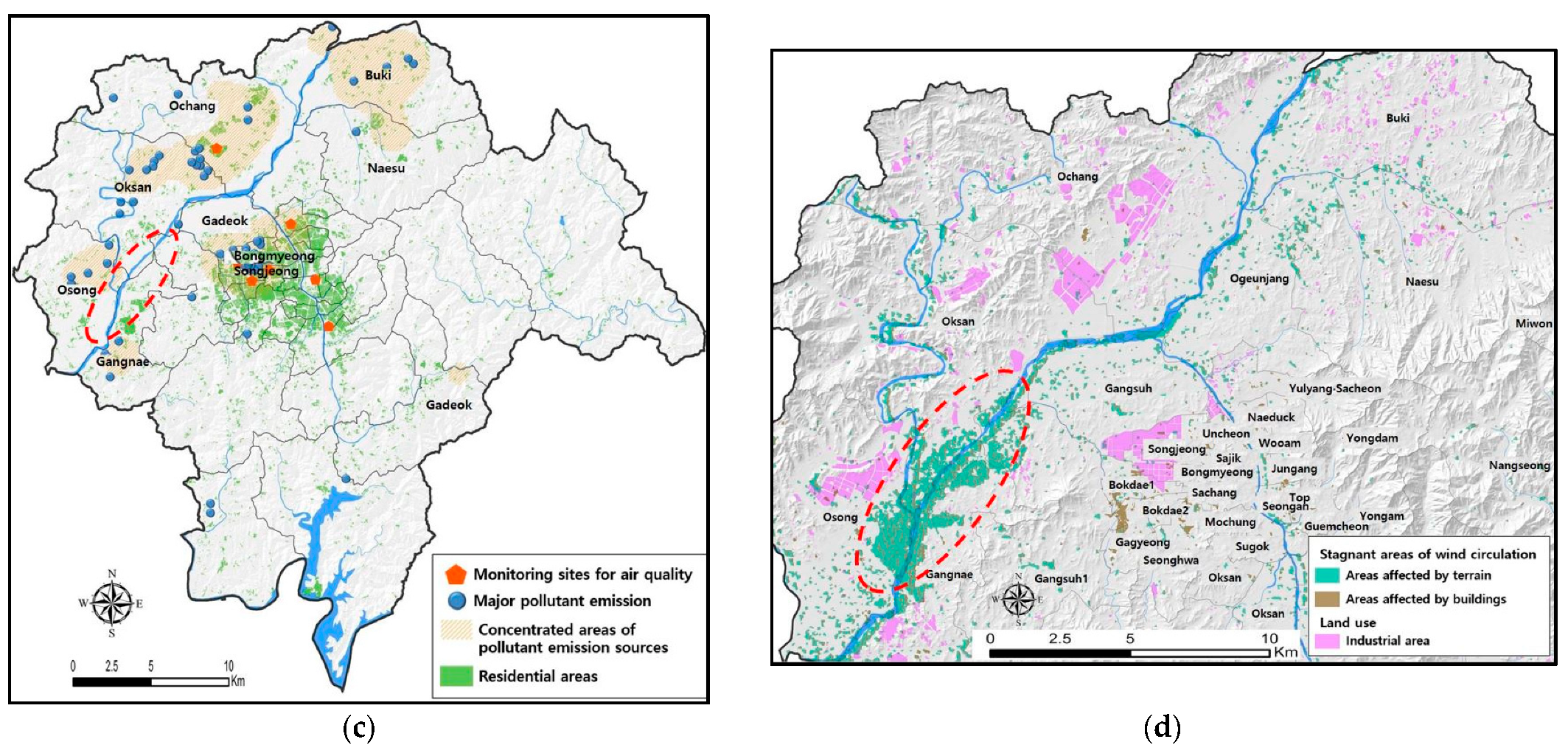
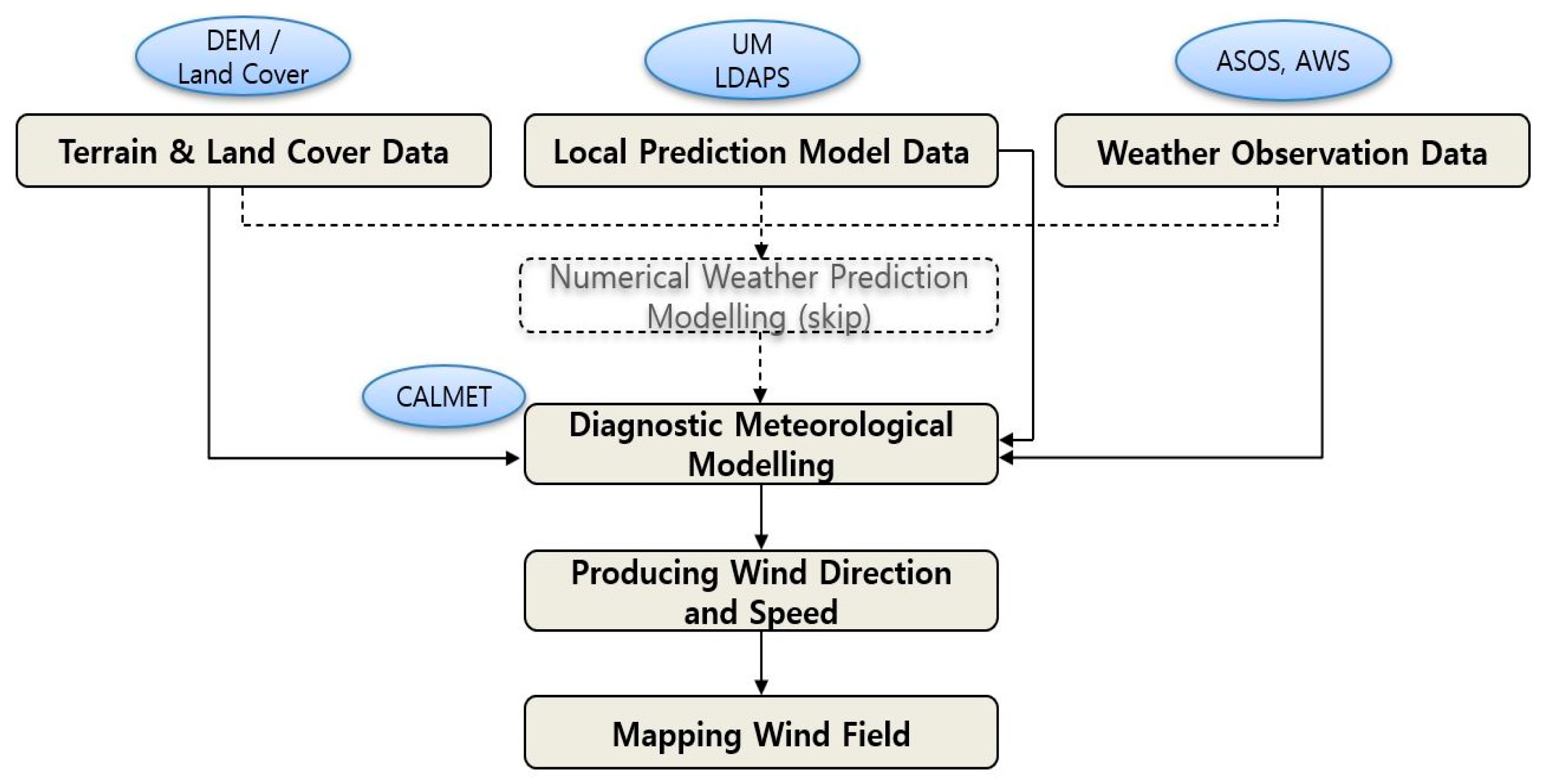
| Planning Unit | Environmental Planning System | Land Planning System | |
|---|---|---|---|
| Nationwide | National Comprehensive Environmental Plan | ⇔ | National Comprehensive Territorial Plan |
| ↓ | ↓ | ||
| Metropolitan cities/provinces | EP for provinces | ⇔ | Comprehensive Plan for Provinces |
| EP for Seoul and other metropolitan cities | ⇔ | Urban master and management plans for metropolitan cities | |
| ↓ | ↓ | ||
| City/county (si/gun) | Si/gun EP | ⇔ | Si/gun master plan, Si/gun management plan |
| Physical Scheme | WRF Option |
|---|---|
| Microphysics | WRF Single-Moment (WSM) 6-class |
| Cumulus parameterization | Kain–Fritsch |
| Longwave radiation | RRTM |
| Shortwave radiation | Goddard |
| Land surface model (LSM) | Noah |
| Surface layer | MM5 similarity |
| Planetary boundary layer (PBL) | Yonsei University (YSU) |
| WRF | CALMET | Benchmark | |||
|---|---|---|---|---|---|
| Wind Speed | Wind Direction | Wind Speed | Wind Direction | ||
| Mean Bias | −0.994 | - | −0.008 | ≤±0.5 m/s (1) | |
| RMSE (Root Mean Square Error) | 1.730 | - | 0.153 | ≤2 m/s (1) | |
| R (correlation coefficient) | 0.364 | - | 0.987 | - | |
| IOA (Index of Agreement) | 0.326 | - | 0.993 | ≥0.6 (1) | |
| MAE (Mean Absolute Error) | - | 67.759 | 12.671 | ≤50° (2) | |
| Data (h) | 8636 | ||||
| Missing data (h) | 148 | ||||
Publisher’s Note: MDPI stays neutral with regard to jurisdictional claims in published maps and institutional affiliations. |
© 2022 by the authors. Licensee MDPI, Basel, Switzerland. This article is an open access article distributed under the terms and conditions of the Creative Commons Attribution (CC BY) license (https://creativecommons.org/licenses/by/4.0/).
Share and Cite
Shin, Y.; Park, S.; Yun, H.; Yu, M. Urban Wind Field Mapping Technique for Municipal Environmental Planning: A Case Study of Cheongju-Si, Korea. Atmosphere 2022, 13, 1805. https://doi.org/10.3390/atmos13111805
Shin Y, Park S, Yun H, Yu M. Urban Wind Field Mapping Technique for Municipal Environmental Planning: A Case Study of Cheongju-Si, Korea. Atmosphere. 2022; 13(11):1805. https://doi.org/10.3390/atmos13111805
Chicago/Turabian StyleShin, Youngkyu, Sangnam Park, Hyerngdu Yun, and Myungsuk Yu. 2022. "Urban Wind Field Mapping Technique for Municipal Environmental Planning: A Case Study of Cheongju-Si, Korea" Atmosphere 13, no. 11: 1805. https://doi.org/10.3390/atmos13111805
APA StyleShin, Y., Park, S., Yun, H., & Yu, M. (2022). Urban Wind Field Mapping Technique for Municipal Environmental Planning: A Case Study of Cheongju-Si, Korea. Atmosphere, 13(11), 1805. https://doi.org/10.3390/atmos13111805




